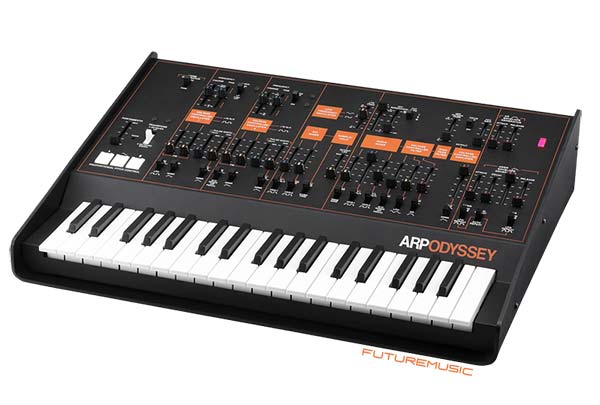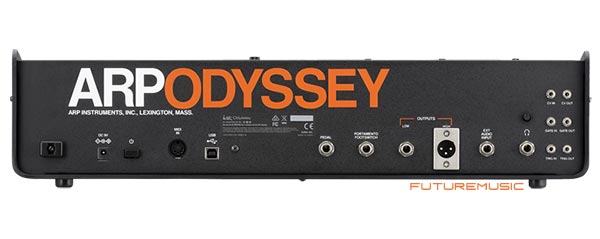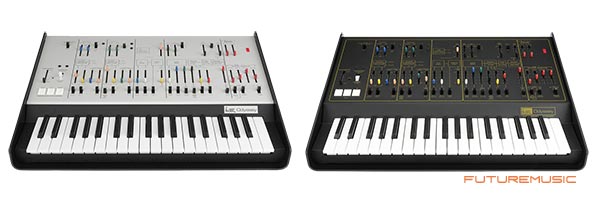Korg has rebooted ARP with the advisory assistance of David Friend, the original co-founder of the famed brand that fell on financial hardship and ceased operations in 1981. of The ARP Odyssey was an analog synthesizer originally produced in 1972 by the American manufacturer ARP Instruments, Inc. that quickly garnered a faithful following among musicians. Well respected for its high value, ease to play and portability, the ARP Odyssey had undergone several improvements during its history and continued to be a long-seller until manufacturing stopped. Now in 2015, KORG has rebooted the ARP Odyssey by completely reproducing the original circuitry for artists looking to recreate classic sounds and explore new ones.

The original ARP Odyssey was a 2VCO duo-phonic instrument. Its most distinctive feature was its sharp, penetrating sound and its rich range of tonal variation. With a variety of functions and modulation possibilities provided by oscillator sync, sample / hold, pulse width modulation, high-pass filter, two types of envelope generator, and pitch bend using the PPC, it was able to create a versatile range of sounds. The ARP Odyssey reproduces the sounds of these components at the circuit level. Under the supervision of David Friend, parts were carefully selected and every detail was adjusted to replicate the original unit’s distinctive synthesis.

There were three versions of the original ARP Odyssey, divided by the date of production, with the major difference being the filter circuit. The ARP Odyssey provides all three of these different filter circuits, and allows you to select one of them with a single switch. TYPE I (Rev1) is a 12 dB/Oct circuit that produces a sharp, punchy sound. TYPE II (Rev2) is a 24 dB/Oct filter with great-sounding lows. TYPE III (Rev3) maintains excellent stability even when resonance is raised. (Including all three filter circuits? Brilliant! —Ed.)
Specifications:
» Keyboard: 37-note (Slimkey, No velocity sensitivity, No aftertouch)
» Maximum Polyphony: 2 voices for duophonic; normally monophonic
» Controllers
— Transpose Positions: 2 octaves down, normal, 2 octave up
— Proportional Pitch Controlb (Pitch down) Pad: about -2 / 3 octave; (Modulation) Pad; # (Pitch-up) Pad: about +2 / 3 octave
» Noise Generator: Noise Spectrum Types (white and pink)
» Portamento
— Maximum Speedabout 0.01 msec./oct
— Minimum Speedabout 1.5 sec./oct
» VCO (Voltage Controlled Oscillator)
— Waveforms: Sawtooth, Square, Pluse (Dynamic Pluse)
— Frequency Range: VCO-1 in low freq. mode, 0.2 Hz – 20 Hz: VCO-1 and VCO-2 (audio range) about 20 Hz – 20 kHz
— Warm Up Drift: 1/30 semitone from turn on max
— Pulse Width: 50 % – 5 %
— Pulse Width Modulation: ADSR, +45 %; LFO, +15 %
— Voltage Controlled Response: 1 V/oct
— Maximum Frequency Shifts: LFO sin wave, +1/2 oct; LFO square wave, +1.5 oct; ADSR, +9 oct; S/H, +2 oct. *VCO-1 is low note priority, VCO-2 is high note priority.
» VCF (Voltage Controlled Filter)
— Types: Low pass (I: 12 dB/oct., II III: 24 dB/oct.)
— Frequency Range: 16 Hz – 16 kHz
— Maximum Usable Q: 30
— Resonance: 1/2 – self oscillate
» VCA (Voltage Controlled Amplifier)
— Dynamic Range: 80 dB
» Ring Modulator
— Type: Digital
— Input Signal: VCO-1, VCO-2 (square wave)
» Sample & Hold
— Command Sources: Keyboard or LFO trigger
— Sampled Signals: VCO-1 sawtooth wave and square wave, VCO-2 square wave and pink noise
» ADSR Envelope Generator
— Attack Time: 5 msec. – 5 sec.
— Decay Time: 10 msec. – 8 sec.
— Sustain Level: 0 – 100 % or Peak
— Release Time: 15 msec. – 10 sec.
» AR Envelope Generator
— Attack Time: 5 msec. – 5 sec.
— Release Time: 10 msec. – 8 sec.
» Control Input Jacks
— Pedal: 6.3 mm monaural phone jack
— Portamento Foot Switch: 6.3 mm monaural phone jack
» Audio Output Jacks
— LOW Connector: 6.3 mm monaural phone jack; Maximum Output Level: -20 dBu@ 10 k load; Output Impedance: 10 Ω
— HIGH Connector: XLR connector; Maximum Output Level: +4 dBu@ 1 k load
— Output Impedance: 330
» Headphones Jack
— Connector: 6.3 mm stereo phone jack
— Maximum Output Level50 mW + 50 mW@ 33 load
— Output Impedance: 10 >> Controllable by volume knob.
» External Audio Input (Ext Audio Input)
— Connector: 6.3 mm monaural phone jack
— Maximum Input Level: -10 dBu
» MIDI IN
» USB Connector Type B
» CV IN/OUT Jacks
» GATE IN/OUT Jacks
» TRIG IN/OUT Jacks
» Power Supply: AC adapter jack (DC 9 V)
» Power Consumption: 6.5 W
» Dimensions (W x D x H) 502 x 380 x 120 mm / 19.76″ x 14.96″ x 4.72″
» Weight: 5 kg / 11.02 lbs
» Included Accessories: AC adapter, phone cable, mini-phone cable, owner’s manual, dedicated semi-hard case
» Options: VP-10 Volume Pedal, PS-1/PS-3 Pedal Switch
On the original ARP Odyssey, the behavior of portamento when using the transpose function differed between Rev1 and Rev2/3. The ARP Odyssey reproduces both of these behaviors and lets you select the desired one with a switch. In order to deliver a more powerful analog sound, a DRIVE switch is provided as a new function. Turning this switch on makes the VCA distort, generating a rough and raw sound.
The ARP Odyssey has been downsized to 86% of the original ARP Odyssey. Carefully selected parts are used in the familiar slider section, providing an operating feel that’s even smoother than the original. The keyboard uses a 37-note slim keyboard that features lighter weight and excellent playability. While making the instrument more compact and easier to use, we have also paid attention to ensuring that the mini-keyboard is uncompromisingly “playable.” Although the keyboard has 37 keys, the transpose function lets it cover a broad range of seven octaves.

Of the various designs that differed by production date, the ARP Odyssey uses the Rev3 design with a black panel silk-screened in orange. The white-paneled Rev1 and the black panel with gold-printed Rev2 designs have also been revived as limited-edition models.
Korg has not officially released pricing or availability for the new ARP Odyssey.
![]()
Korg
![]()






